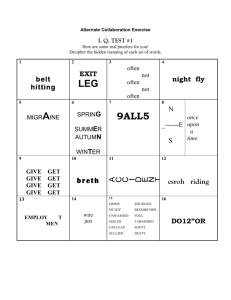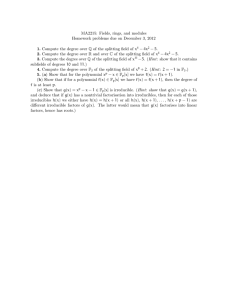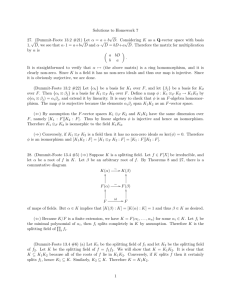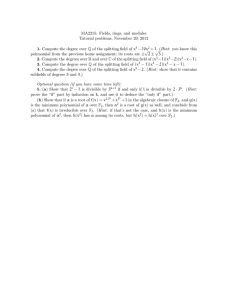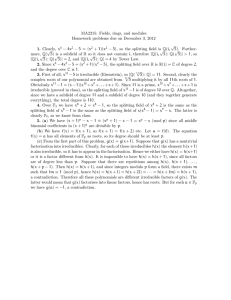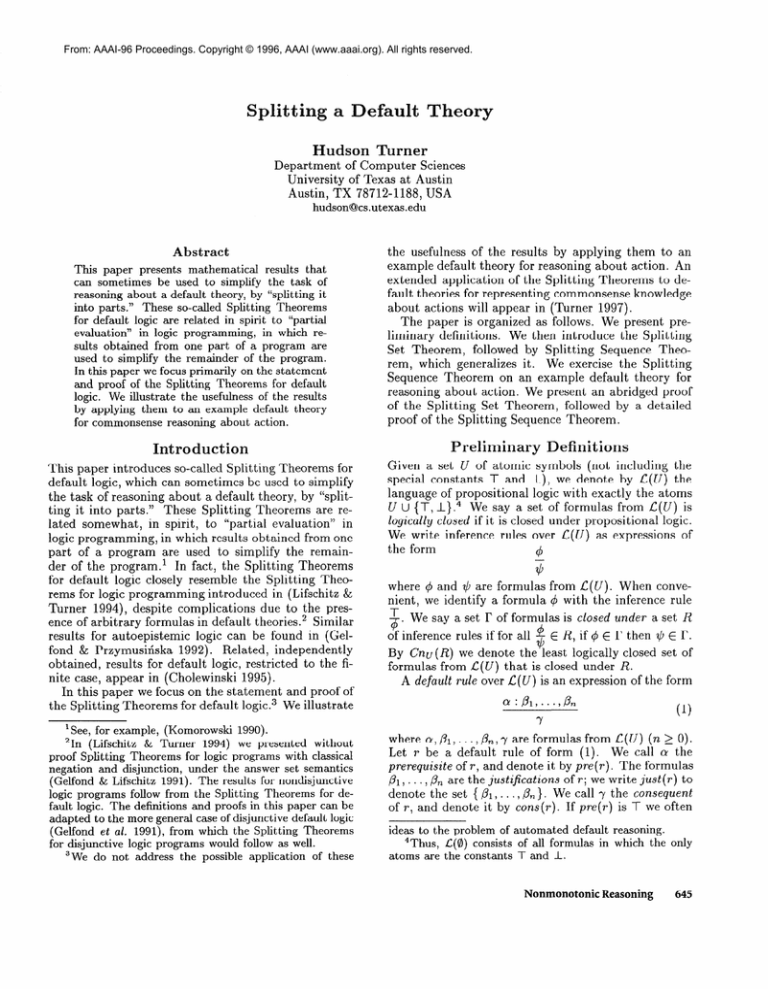
From: AAAI-96 Proceedings. Copyright © 1996, AAAI (www.aaai.org). All rights reserved.
Splitting
a
Hudson
efault
Theory
Turner
Department
of Computer Sciences
University of Texas at Austin
Austin, TX 78712-1188,
USA
hudson@cs.utexas.edu
Abstract
This paper presents mathematical
results that
can sometimes be used to simplify the task of
reasoning about a default theory, by “splitting it
into parts.” These so-called Splitting Theorems
for default logic are related in spirit to “partial
evaluation” in logic programming,
in which results obtained from one part of a program are
used to simplify the remainder of the program.
In this paper we focus primarily on the statement
and proof of the Splitting Theorems for default
logic. We illustrate the usefulness of the results
by applying them to an example default theory
for commonsense reasoning about action.
the usefulness of the results by applying them to an
example default theory for reasoning about action. An
extended application of the Splitting Theorems to default theories for representing commonsense knowledge
about actions will appear in (Turner 1997).
The paper is organized as follows. We present preliminary definitions.
We then introduce the Splitting
Set Theorem,
followed by Splitting
Sequence Theorem, which generalizes it. We exercise the Splitting
Sequence Theorem on an example default theory for
reasoning about action. We present an abridged proof
of the Splitting Set Theorem,
followed by a detailed
proof of the Splitting Sequence Theorem.
reliminary
Introduction
This paper introduces so-called Splitting Theorems for
default logic, which can sometimes be used to simplify
the task of reasoning about a default theory, by “splitThese Splitting Theorems
are reting it into parts.”
lated somewhat,
in spirit, to “partial evaluation”
in
logic programming,
in which results obtained from one
part of a program are used to simplify the remainder of the program. ’ In fact, the Splitting Theorems
for default logic closely resemble the Splitting Theorems for logic programming
introduced in (Lifschitz &
Turner 1994), despite complications
due to the presence of arbitrary formulas in default theories.2 Similar
results for autoepistemic
logic can be found in (Gelfond & Przymusinska
1992).
Related, independently
obtained, results for default logic, restricted to the finite case, appear in (Cholewinski
1995).
In this paper we focus on the statement and proof of
the Splitting Theorems for default logic.3 We illustrate
‘See, for example, (Komorowski
1990).
21n (Lifschitz
& Turner 1994) we presented without
proof Splitting Theorems for logic programs with classical
negation and disjunction, under the answer set semantics
(Gelfond & Lifschitz 1991).The results for nondisjunctive
logic programs follow from the Splitting Theorems for default logic. The definitions and proofs in this paper can be
adapted to the more general case of disjunctive default logic
(Gelfond
et ad. 1991),f rom which the Splitting Theorems
for disjunctive logic programs would follow as well.
3We do not address the possible application
of these
Definitions
Given a set U of atomic symbols (not including the
T and I), we denote by ,C(U) the
special constants
language of propositional
logic with exactly the atoms
U u {T, I} .4 We say a set of formulas from L(U) is
logically closed if it is closed under propositional
logic.
We write inference rules over ,C( U) as expressions
of
the form
4
s
where 4 and $ are formulas from l(U).
When convenient, we identify a formula 4 with the inference rule
We say a set I of formulas is closed under a set R
$.
of inference rules if for all k
lc, E R, if 4 E I? then $ E I.
By Gnu(R) we denote the least logically closed set of
formulas from .C( U) that is closed under R.
A default rule over ,C( U) is an expression of the form
of : Pl
, * . * , Pn
(1)
7
are formulas from -C(U) (n 2 0).
~,A,.
. .,,&,y
Let T be a default rule of form (1).
We call a the
prerequisite of T, and denote it by pre(r). The formulas
are the justifications of r; we write just(r) to
Pl,-,A
denote the set { ,&, . . . , ,&}. We call y the consequent
of r, and denote it by cons(r). If pre(r) is T we often
where
ideas to the problem of automated default reasoning.
4Thus, C(0) consists of all formulas in which the only
atoms are the constants T and 1.
NonmonotonicReasoning
645
omit it, writing
we identify
’Ply . ’. ’@72 instead.
If just(r)
= 0,
Y
?=with the corresponding
inference rule 7.”
A default theory
over L(U). Let D
E a set of formulas
denoted by DE, is
pre(r)
cons(r)
over ..C(U) is a set of default rules
be a default theory over ,C(U), and
from L(U). The reduct of D by E,
the following set of inference rules.
. r E D and for all ,O E just(r),
*
l/3 r$ E
Sets
Let D be a default theory over ,C(U) such that, for every rule T E D, pre(r) is in conjunctive
normal form.
(Of course any default theory can be easily transformed
into an equivalent default theory, over the same language, satisfying this condition.)
For any rule r E D,
a formula +4 is a constituent of T if at least one of the
following conditions holds: (i) 4 is a conjunct of pre( r);
(ii) 4 E just(r);
(iii) q5= cons(r).
A splitting set for D is a subset A of U such that for
every rule r E D the following two conditions hold.
o Every constituent
of r belongs
o If cons(r) does not belong
default rule over L(A).
avb:a,b
aA(cvd):ld
bA(cvd):x
cvd
Td
1C
Take A3 = {a, b}. It’s easy to verify that A3 splits D3,
with
bA3(D3) =
q,
7
.
1
1
Notice that default theory bA3(D3) over IC(A3) has two
consistent extensions:
&A,
({a}) and &A, ((b}).
Given a splitting set A for D, and a set X of formulas from l(A),
the partial evaluation of D by X with
respect to A, denoted by eA (D, X), is the default theory over ,C( U \ A) obt ained from D in the following
manner. For each rule r E D \ bA(D) such that
5Allowing the emp t y set of justifications
is mathematically convenient
(Brewka
1991; Marek & Truszczyriski
1993), although it seems Reiter (Reiter
1980) may have
meant to prohibit it.
646
KnowledgeRepresentation
to C(A)
belongs
has its complement
there is a rule r’ E eA (D, X)
also
in CnA (X)
such that
o pre(r’)
is obtained from pre(r) by replacing each
conjunct of pre(r) that belongs to ,C(A) by T, and
e just(r’)
= just(r)
For example,
eA3(D3,
r~ L(U \ A), and
= cons(r).
it is easy to verify that
CnA3({a}))
=
&
=
{ 2,
, T A +Idd)
: ld
}
and that
eA3(D3, cu3({b)))
T * (c_vcd) ’lc
}.
Let A be a splitting set for D. A solution to D
with respect to A is a pair (X, Y) of sets of formulas
satisfying the following two properties.
o X is a consistent
bA(D) over ,C(A).
extension
of the default
theory
o Y is a consistent
extension
eA (D, X) over l(U \ A).
of the default
theory
For example, given our previous observations,
it is
easy to verify that 03 has two solutions with respect
to A3:
and
( cn&
to ,C(A) U ,C(U \ A).
to ,C(U \ A), then r is a
If A is a splitting set for D, we say that A splits D.
The base of D relative to A, denoted by PA,
is the
default theory over L(A) that consists of all members
of D that are default rules over L(A).
Let Us = {a, b, c, d}. C onsider the following default
theory 03 over Ic(U3).
:1 b :~a
-a
b
e no member of just(f)
0 cons(+)
We say E is an extension of D if E = Gnu (DE) .
Default logic is due to Reiter (Reiter 1980).
The
(essentially
equivalent)
definitions given above follow
(Gelfond et aZ. 1991). Although the definitions in this
section are stated for the propositional
case, they are
taken, in the standard way, to apply in the first-order,
quantifier-free
case as well, by taking each non-ground
expression to stand for all of its ground instances.
Splitting
e every conjunct of pre(r) that
belongs to &A (X), and
({a)) > cnU3\A3
({c, +})
)
( cn& tjb)) 7 Cn~~\A~t{lC~
d)) > .
Splitting Set Theorem.
Let A be a splitting set for
a default theory D over ,C(U). A set E of formulas is
a consistent extension of D iff E = Cnu(X U Y) for
some solution (X, Y) to D with respect to A.
Thus,
for example,
it follows from the Splitting Set Theorem
that default theory 03 has exactly two consistent extensions:
Cnu3 ({ a, c, ld}) and
Cw,({b,
=,
4).
Splitting Set Corollary.
Let A be a splitting set for
a default theor.y D over L(U).
If E is a consistent
extension of D, then the pair
\
(En-W),
is a solution
EnW\A)
to D with respect
Splitting
I
>
to A.
Sequences
A (transfinite)
sequence is a family whose index set
is an initial segment of ordinals {CV : 0 < ,u}. We
if
say that a sequence (Acu)a<P of sets is monotone
A, E Ap whenever (;Y< ,B, and continuous if, for each
limit ordinal cr < ,u, A, = U,< cyA,.
A splitting sequence for a default theory D over
l(U)
is a nonempty, monotone,
continuous sequence
of
splitting
sets
for
D
s.t.
UcwCPA, = U.
h&<P
lHoZds( Up&$),
SO) A lHoZds( Up(Right),
So) A lHoZds(SpiZZed, So)
Precedes (So, 5’1) A Occurs (Raise (Left), So) A Occurs (Rarise( Right), SO)
Precedes(S1,
S,) A Occurs(Lower(Left),
&curs(Raise(x),
s) A Precedes(s,
HoZds( Up(x), s’)
s’)
Occurs(Lower(x),
s) A Precedes(s,
lHoZds( Up(x), s’)
HoZds( Up(Left), s) $ HoZds( Up(Right),
Holds (Spilled, s)
Holds (f, s) A Precedes (s, s’) : Holds (f, s’)
Holds ( f, s’)
Figure
of a solution with respect to a splitting
to splitting sequences as follows. Let
be a splitting sequence for D. A solution
A = (JL)~<~
to D with respect to A is a sequence (E,)cu<P of sets of
formulas that satisfies the following three conditions.
theory
of the default
o For any a such that LY+ 1 < p, E,+l
extension of the default theory
theory
is a consistent
overC(A,+l \ &J.
We generalize
ct < ,u, E,
the Splitting
= Cq (0).
Set Theorem
as follows.
Splitting
Sequence Theorem.
Let A = (A,),cl,
be a splitting sequence for a default theory D over
L(U). A set E of formulas is a consistent extension of
D if and only if
E=
for some solution
Gnu
(Ecu)cu<p to D with respect
to A.
The proof of the Splitting Sequence Theorem, which
appears in later in the paper, relies on the Splitting
Set Theorem.
We also have the following counterpart
to the Splitting Set Corollary.
Splitting
Sequence Corollary.
Let A = (ACY)CY<ti
be a splitting sequence for a default theory D over
be the sequence of pairwise disjoint
WJ>.
Let (u&dp
subsets of U such that for all CY< 1-1
= Aa \ u
UCX
If E is a consistent
(E f-l Wa)
A,.
extension of D, then the sequence
)cu<P is a solution to D with respect to A.
Splitting a Default Theory
easoning About Action
We will illustrate
the use of the Splitting
Sequence
Theorem by applying it to a default theory that formalizes commonsense
knowledge about actions.
The
action domain we formalize is based on the “Soup
Bowl” example from (Baral 8z Gelfond 1993), which
involves reasoning
about the effects of concurrent
actions.6
The default logic formalization
we consider relies, implicitly, on the notion of “static causal
laws,” recently investigated in (McCain & Turner 1995;
Turner 1996).
Default
o For any limit ordinal
s)
D1
Example:
set is extended
o Eo is a consistent
extension
PA,
over L(Ao).
s’)
7 Holds f, s A Precedes s, s’ : -, Holds f, s’
lHoZds(f, s’)
1: Default
The notion
S,)
Theory
D1
We will formalize the following action domain in default logic. There is a bowl of soup. There are actions
that raise and lower its left and right sides.
If one
side of the bowl is up while the other is not up, the
soup is spilled. In the initial situation So, both sides
of the bowl are not up, and the soup is not spilled. We
let 5’1 be the situation that would result from raising
both sides of the bowl simultaneously.
Notice that, intuitively speaking, it follows that in situation S1 both
sides of the bowl are up and the soup is not spilled.
We also consider an additional situation 5’2 that would
result from lowering the left side of the bowl, when
in situation 5’1. Intuitively speaking, we can conclude
that in situation Sa the left side of the bowl is not up,
the right side is up, and the soup is spilled.
We will use the Splitting
Sequence
Theorem
to
demonstrate
that the default theory D1, shown in Figure 1, is a correct formalization
this action domain.
More precisely, what we will show is that the literals HoZds( Up(Left), S,), HoZds( Up(Right), S,), and
of delHoZds(SpiZZed, S,) are among the consequences
that D1 correctly
fault theory D1, which establishes
describes the values of the fluents in situation 5’1.
6We will not a ttempt in this paper a general analysis of
the problem of representing commonsense knowledge about
concurrent actions. Nor will we attempt a general justification of the style of representation
employed in the example
default theory itself. Such analysis and justification
is an
important problem that is beyond the scope of this paper.
NonmonotonicReasoning
647
lHoZds( Up(Left),
Precedes(So,
SO) A lHoZds( Up( Right), SO) A yHoZds(SpiZled, SO)
5’1) A Occurs(Raise(Left),
Precedes(&,
HoZds(Up(Left),
j
Figure
S,)
HoZds( Up(Left), SI) f Holds{ Up(Right),
Holds (Spilled, S,)
Sll
&)
: lHoZds( UpcLeft), Sl)
lHoZds( Up(Left), S,)
SO) f Holds( Up(Right),
2: Default
HoZds( Up(Right),
HoZds( Up&e.@
So) A Occurs(Raise(Right),
S2) A Occurs(Lower(Left),
: lHoZds( Up(Right), S,)
lHoZds( Up(Right), S1)
theory
3: Default
theory
Holds( up(Left),
S2)
S2)
SO) , lHoZds(
-HoZds(SpilZed,
Eo)
Occurs(Raise(Left),
Precedes(S1,
S2)
HoZds( Up(Left), 5’2) f HoZds( Up(Right),
Holds (Spilled, S2)
: HoZds( Up(Left),
bAO(01)
-+fozds( up&$),
e& (bag (Dl),
-HoZds( Up(Left),
So)
Notice that A0 splits D1, with bAO(01) the default theory over lT(Ao) shown in Figure 2.
We obtain Al by adding to A0 all ground instances
in ,Cl of HoZds(f, Sr). Finally, let A2 = Z.71.One easily
checks that (Ao, Al, A 2) is a splitting sequence for D1.
Let Xe consist of the following literals:
: lHoZds(SpiZZed, Sl)
1 Holds (Spilled, 5’1)
Figure
Sz)
: HoZds( Up(Right), &)
HoZds( Up(Right), S2)
4: Default
theory
eA1 (bA2(Dl),
Splitting
Default
Theory
D1
Before applying the Splitting
Sequence Theorem,
we
must be more precise about the language of D1.
Let Ul consist of all ground atoms of the following
many-sorted,
first-order language ,Cr. The sorts of ,Cr
are situation, action, fluent and side. There are object constants 5’0, Sr and 5’2 of sort situation, Left and
Right of sort side, and Spilled of sort fluent.
There
is a unary function symbol Up of sort side --+ fluent,
and unary function symbols Raise and Lower of sort
side -+ action.
There is a binary predicate symbol
Holds of sort fluent x situation,
a binary predicate
symbol Occurs of sort action x situation, and a binary
predicate symbol Precedes of sort situation x situation.
We take D1 to be the (propositional)
default theory
over ,C( VI) consisting of all ground instances in ,Ci of
the rules shown in Figure 1.
Now we can specify a splitting
sequence for D1,
which will allow us to break D1 into simpler parts.
To begin, let A0 consist of all ground instances in ,Ci
of the following atoms:
Holds(f,
648
So) , 0 ccurs(u,
s) , Precedes(s,
KnowledgeRepresentation
s’) .
So) , Precedes(So,
So) ,
5’1) ,
So) ,
S2) , Occurs (Lower( Left), 5’1) .
Take
EO
=
CnAo(XO).
Notice that Eo is the unique extension of bA,, (01).
The default theory e&(bA, (Dl), Eo) over lC(Ai \/lo)
is (essentially)
as shown in Figure 3.
Thus, if we take Xr to consist of the literals
Eo U El)
Similarly, we will also show that D1 entails the literals lHoZds( Up(Left), S’s), HoZds( Up(Right), S2), and
Holds (Spilled, S2), which establishes that D1 also correctly describes situation S2.
Up(Right),
So) , Occurs(Raise(Right),
Holds{ Up(Left),
Figure
So)
S,)
2%)) HoZds( Up(Right),
SI) ,
lHoZds(SpiZZed, S1) ,
and let
El =
CnA~\Ao txl)
we find that El is the unique extension
ory eA,(bA#h),
of default
the-
Eo).
theory
that
the
default
Finally,
observe
eAl(b&(D1),
Eo U El) over C(A2 \ Al) is essentially
as shown in Figure 4.
Let X2 consist of the literals
lHoZds( Up(Left),
5’2) , HoZds( Up(Right),
S2) ,
Holds (Spilled, S2) .
Take
E2 =
cnAz\A1
(x2) -
It is not difficult to verify that E2 is the unique extension of eA1 (bAz(D1), Eo U El).
We have shown that (Eo, El, E2) is a solution to default theory D1 with respect to (Ao, Al, AZ). In fact it
It follows by the Splitting Seis the unique solution.
quence Theorem that Gnu, (Eo U El U E2) is the unique
consistent extension of D1.
This shows that the literals HoZds( Up(Left), S,),
and 1 Holds (Spilled, S, ) are
HoZds( Up(Right), &),
among the consequences of D1, which, as we discussed
previously, is intuitively correct.
We have similarly
established
that
the literals -4Yolds(Up(Left),
&), HoZds(Up(Right),
Sz), and
of D1,
Holds (Spilled, 5’2) are among the consequences
which is again the intuitively correct result.
Proof of the Splitting
Set Theorem
Due to space constraints,
we present an abridged proof
of the Splitting Set Theorem, omitting several intermediate lemmas, and proofs of the remaining lemmas.
Lemma 1 Let U, U’ be disjoint sets of atoms. Let R
be a set of inference rules over ,C( U), and R’ a set of
inference rules over C(V).
Let X = Cnuuut (R U R’).
e If X is consistent,
e X = Cnuvul
then X f7 ,C(U) = Cnv(R)
(Gnu(R)
.
o b;(D)
: cons(r)EL(U\A))
= D \ t;(D)
The advantage of these alternative definitions is captured in the following key lemma, which fails to hold
for their counterparts
bA (D) and D \ bA (D).
Lemma 2 Let D be a default theory over l(U)
with
splitting set A. For any set X of formulas from L(U),
bL(D)x
= b>(Dx)
and t2(D)x
= t>(DX).
The proof will also make use of the following additional alternative definitions.
Given a set X of formulas from L(A), let ei (D, X)
be the default theory over ,C(U \ A) obtained from D
in the following manner. For each rule r E t> (0) s.t.
e every conjunct of pre (r) that
belongs to CnA (X), and
o no member
of just(r)
to L(A)
belongs
has its complement
there is a rule r’ E ei (D, X)
also
in CnA (X)
such that
a pre( r’)
is obtained from pre( r) by replacing each
conjunct of pre(r) that belongs to C(A) by T, and
e just(r’)
0 cons(r’)
= just(r)
n,C(U\A),
@ E nL(A)
and
= cons(r).
Notice that e> differs from eA only in starting with
the rules in t>(D) instead of the rules in D \ bA (D).
Finally, let s>(D) be the set of all pairs (X, Y) s.t.
e X is a consistent
extension
of b>(D),
e Y is a consistent
extension
of e: (D, X) .
and
The following lemma shows that these alternative
definitions are indeed suitable for our purpose.
End]
= CnA[b>(D)
* E = Cnu[(E
n l(A))
and
U tL(D)E].
Lemma 5 Let D be a default theory over it(U) split
by A. Let E be a logically closed set of formulas from
L(U), withX = ErM(A)
andY = EM(U\A).
We
have Cnu[X
U R’) .
In proving the Splitting Set Theorem it is convenient
to introduce a set of alternative
definitions,
differing
very slightly from those used in stating the theorem.
(We nonetheless prefer the original definitions, because
they are more convenient in applications
of the Splitting Theorems.)
Let D be a default theory over ,C(U) split by A. We
define the following.
e tl(D)={r~D
Lemma 4 Let D be a default theory over ,C(U) with
splitting set A. Let E be a consistent set of formulas
from ,C(U). E = Cnu(DE)
if and only if
U e> (D,X)y]
= Cnv[X
~t>(D)~l.
Given a default theProof of Splitting Set Theorem,
ory D over L(U) with splitting set A, we know by
Lemma 3 that s2 (D) is precisely the set of solutions
to D with respect to A. We will show that E is a consistent extension of D if and only if E = Cnu(X U Y)
for some (X,Y)
E s>(D).
(+)
Assume E is a consistent
extension
of D.
Let X
= E n L(A)
and Y = E n c(U \ A).
By Lemma
4, X
=
CnA(b>(D)X)
and E
=
By Lemma 5, E = Cnv(X
U
Cnu(X U t>(D)E).
eL (D, X)y>.
By
Lemma
1, we can
conclude
that
Y = CnU\A(e> (D,X)y).
So we have established that
(X, Y) E sf4 (D). We can also conclude by Lemma 1
E =
that
Cnu[XUCn
U\A (e> (Q
Y = cnu\A(e> (D,X)y),
(+)
Assume
E
=
(X,Y)
f s>(D).
Since
Y
=
cnu\A(e;
Cnu\A(e>
that
(D,X)y).
(D,X)y)].
E = Cnu(X
X>y)].
since
And
we have E = Cnu(X U Y).
Cnu(X
U Y)
for some
(X,Y)
E s;(D),
we have
Hence
By Lemma
U e> (D,X)y).
E
=
Cnu[X
U
1, we can conclude
Thus,
by Lemma
5,
E = Cnu(X Ut>(D)E).
By Lemma 1, En ,C(A) =
CnA (X) , and since X is logically closed, CnA (X) = X.
So E n C(A) = X. Since (X,Y)
E s>(D),
we have
X = CnA(bi(D)X).
that E = Cnu(DE).
We can conclude
by Lemma
4
cl
Assume that E is a
Proof of Splitting Set Corollary.
consistent extension of D. By the Splitting Set Theorem, there is a solution (X, Y) to D with respect to
A such that E = Cnu(X UY).
Since X & L(A) and
Y 2 ,C( U \ A), we can conclude by Lemma 1 that
E fl L(A) = CnA (X) . And since X is logically closed,
CnA(X)
= X. So En L(A) = X. A symmetric
argu0
ment shows that E n ,!Z(U \ A) = Y.
roof of Splitting
Sequence
heorem
Lemma 6 Let D be a default theory over ,C(U) with
splitting sequence A = (ACY)CY<p. Let E be a set of
formulas from l(U).
Let X = (X,),,,
be a sequence
of sets of formulas from J(U) such that
Lemma 3 If a default theory D over ,C(U) is split by
is precisely the set of solutions to D
A, then sL(D)
with respect to A.
e Xc,=
EfM(Ao),
Now we present the two main lemmas, and then use
them to prove the Splitting Set Theorem.
If E is a consistent
e for all o s.t. a + 1 < p, X,+1
e for any limit ordinal a < p, X,
extension
to D with respect to A.
= En .C(A,+l
\ A,),
= Cna (0).
of D, then X is a solution
NonmonotonisReasoning
649
Proof.
There are three things to check.
First, by the Splitting Set Corollary, we can conclude
that E nL(A0 )is a consistent extension of bAO(D).
Second, choose a such that o + 1 < p. We must
show that X,+1 is a consistent extension.of
(2)
Let /3 = cy + 1. By the Splitting Set Corollary, E n
,lZ(Ap) is a consistent
extension of bAg (D). Let D’ =
bAg (D) and let E’ = E n ,C(As).
By the Splitting
Set Corollary, since A, splits D’ , E’ n l(As \ ACY) is
a consistent
extension of e& (D’, E’ n ,C( A,)).
It is
easy to verify that X,+1 = E’ f7 ,C(Ap \ ACY). It is not
difficult to verify also that eA, (D’, E’ fl L(A,))
is the
same as (2).
Third, for any limit ordinal a < p, X, = Cns(0).
cl
Lemma 7 Let D be a default theory over ,C(U) with
splitting sequence A = (A,)a<P.
Let (ECY)(Y<P be a
solution to D with respect to A. For all a < 1-1
CnA,
is a consistent
Proof.
extension
under bAy ( D)x7, which contradicts
the fact that, by
the inductive hypothesis, X7 is a consistent extension
So we have shown that X, is closed under
of bA,(D).
bA,(D)xa.
Now, let E = CnAa(bA,(D)XOr).
We will show that
E = X,, from which it follows that X, is a consistent
extension of bAa (0).
S ince X, is logically closed and
closed under bAQ(D)x0,
we know that E C X,. Suppose E # X, , and consider any formula 4 E X, \ E.
Since A is continuous and CEis a limit ordinal, there
must be a y < o such that 4 is from ,C( A?) and
therefore 4 E X,.
Thus, X, is a proper superset of
E n L(A,).
By the inductive hypothesis,
we know
that X7 is a consistent
extension of bA,(D).
Thus,
X7
=
CnA,(bAy(D)XY).
And
bA,(D)xy
since
=
we have X, = CnA,(bA,(D)x=).
Since
by tDjxa,
E=
cnA,(bAa(D)xa)
and bA,(D)xa
E bA,(D)Xa,
we know that E is closed under bAy (D)xa.
Moreover, since bAy ( D)xe
E fl L(A,)
is a default
theory
is closed under bA,(D)xe.
over L(A,)
But
X,
,
is the
least logically closed set closed under bA7 ( D)xe,
so
X, E EnC(A,),
w h ic h contradicts
the fact that X, is
a proper superset of E n ,C(A,). We can conclude that
cl
E = X,, which completes the second case.
Let D be a default theory over L(U) with splitting
sequence A = (Acu)a<P. The standard’extension
of ;i
is the sequence B = (Ba)cu<p+i such that
of bA, (0).
For all (Y < ,u, let
o for all a < p, B,
= A, , and
e B,=U.
Proof is by induction on o. Assume that for all y < a,
We’ll show
X, is a consistent
extension of bAy (D).
that X, is a consistent
extension of t)~, (D).
There
are two cases to consider.
Case 1: Q is not a limit ordinal. Choose y such that
y + 1 = a. By the inductive hypothesis,
Xh is a consistent extension of bA, (D). We also know that E, is
a consistent extension of eA, (bALI(D), UPC,, Es). Let
= bA (D). It is clear that bA (0) = %A (0’).
It
t’not di&cult to verify that eA,(aA, (D), U,;,
Ep) is
the same as eA,(D’, X-,). So we’ve shown that X, is a
consistent extension of bA (D’) and that E, is a consistent extension of eA,(o7/, X7). By the Splitting Set
Theorem,
it follows that &A, (X, U Ea) is a consistent extension of D’. And since it’s easy to check that
we’re done with the first case.
CnA,(X,
u -&) = X,,
Case 2: cy is a limit ordinal. First we show that X,
is closed under bA, ( D)xp.
So suppose the contrary.
Thus there is an r E ~A,(D)~,
such that pre(r) E X,
Since
and cons(r) $! X,.
- . A’ is continuous and cr is a
limit ordinal, we know there must be a y < a such
Since bAy (D) is a default theory
that T E b~,(D)~a.
over l(A,),
we have bA,(D)xe
bA,(D)x7
- Furthermore,
and cons(r) +i X7. This
650
= bA,(D)xy.
it follows that
shows that X,
KnowledgeRepresentation
So r E
pre(r) E X,
is not closed
Notice that the standard
splitting sequence for D.
extension
of A is itself
a
Lemma 8 Let D be a default theory over ,C(U) with
splitting sequence A = (A,),cP.
Let B = (Ba)cu<P+l
be the standard extension of A. Let X = (X,),,,
be
a sequence of sets of formulas from C(U).
Let Y =
(Y,)cy<P+l be defined as follows.
e Foralla<p,Y,=X,.
9 Up = Cn0(0).
If X is a solution to D with respect to A, then Y is a
solution to D with respect to B.
First, it’s clear that Ye is a consistent extenProof.
sion of bg, (D), since Ye = X0, bB,(D) = bA,(D), and
X0 is a consistent extension of bAn(D). Similarly, it’s
clear that for any a such that cry l’< p, %+I is a
consistent extension of
We also know that for any limit ordinal (Y < p, Y, =
Cnm(8).
It remains to show that we handle p correctly.
There are two cases to consider.
Case 1: p is a limit ordinal.
In this case we must
show that Yp = Cq(Q)),
which it does.
Case 2: /-1is not a limit ordinal. In this case, choose
a, such that Q + 1 = ~1. We must show that Yp is a
consistent extension of the default theory
Acknowledgments
Many thanks to Vladimir Lifschitz and Norm McCain.
This work was partially supported by National Science
Foundation grant IRI-9306751.
(3)
over ,C(B, \ BCY) . Since A is a splitting sequence for a
default theory over Z(U), we know that U,,,
A, = U.
Moreover, since A is monotone
and 1-1is not a limit
ordinal, it follows that A, = U. And since B, = A,,
we know that bga (D) = D. It follows that default
theory (3) is empty. It also follows that B, \ B, = 0,
Since YcL = Cn0(0), we
so the language of (3) is t(0).
have shown that Yp is a consistent extension of (3). •I
(3)
assume
Proof of Splitting Sequence Theorem.
that E is a consistent extension of D. By Lemma 6,
there is a solution
(Ecu)cu<p to D with respect to
for which it is not difficult to verify that
w&<P
E=CnU
(+) Assume that X = (X,>,<,
with respect to (A,),cp.
Let
E=
is a solution
to D
Gnu
be the standard
extension
of
- By Lemma 8, we know there is a solution
to D with respect to B such that
Let B = (&)a<p+l
mJa<IL
Paw+1
E = Cw ( U
\a<fi+l
Y-J
.
/
Moreover, we know there is an o < p + 1 such that
B, = U. Thus bB, (D) = D and
It follows by Lemma
of D.
7 that E is a consistent
extension
0
Assume that
Proof of Splitting Sequence Corollary.
E is a consistent
extension
of D.
By the Splitting
Sequence Theorem,
there is a solution (X,),,,
to D
to A such that E = Gnu /Jcucp X,
.
>
(
We will show that for all a < p, E n L( Ua!) = X, .
Consider
any ct < 1-1. We
Let X = UacpXcu.
with respect
have X,
E L(Ua), X \ X,
C ,C(U \ U,), and E =
Th us, by Lemma 1 we can conCnu(X,
U X \ X,).
clude that E fl L(Uor) = Gnu, (X,) . And since X, is
q
logically closed, we have Gnu, (X,) = X, .
References
Baral, C., and Gelfond, M.
current actions in extended
Proc. of IJCAI-93, 866-871.
Besnard, P. 1989.
Springer-Verlag.
1993. Representing
logic programming.
An Introduction
to Default
conIn
Logic.
Reasoning: Logical
Brewka, G. 1991. Nonmonotonic
Foundations of Commonsense.
Cambridge University
Press.
Cholewinski,
P. 1995. Reasoning with stratified default theories. In Proc. of 3rd Int ‘1 Conf. on Logic Programming and Nonmonotonic
Reasoning, 273-286.
Gelfond, M., and Lifschitz, V. 1991. Classical negation in logic programs and disjunctive databases.
New
Generation Computing 91365-385.
Gelfond, M., and Przymusinska,
H. 1992.
sistency and completeness
of autoepistemic
Fundamenta Informaticae XVI:59-92.
On contheories.
Gelfond, M.; Lifschitz,
V.; Przymusinska,
H.; and
Truszczynski,
M. 1991. Disjunctive defaults. In Allen,
J.; Fikes, R.; and Sandewall, E., eds., Principles of
Knowledge Representation
and Reasoning:
Proc. of
the 2nd Int ‘1 Conference, 230-237.
Towards
Komorowski,
J.
1990.
methodology
founded
on partial
Proc. of ECAI-90.
a programming
deduction.
In
Lifschitz, V., and Turner, H. 1994. Splitting a logic
program. In Van Hentenryck,
P., ed., Proc. Eleventh
Int ‘1 Conf. on Logic Programming, 23-37.
Marek, W., and Truszczynski,
tonic Logic: Context-Dependent
Verlag.
M. 1993. NonmonoReasoning. Springer-
McCain, N., and Turner, H. 1995. A causal theory of
ramifications
and qualifications.
In Proc. of IJCAI95, 1978-1984.
Poole, D. 1993. Default logic. In Gabbay, D.; Hogger,
C.; and Robinson, J., eds., The Handbook of Logic in
AI and Logic Programming, volume 3. Oxford University Press. 189-215.
Reiter, R. 1980. A logic for default
fzcial Intellige nce 13( 1,2):81-132.
reasoning.
Arti-
Turner, H. 1996. Representing actions in default logic:
In Working Papers
A situation calculus approach.
of the Third Symposium on Logical Formalizations
of
Commonsense
Reasoning.
Turner, H. 1997. Representing
actions in logic programs and default theories: A situation calculus approach. Journal of Logic Programming. Forthcoming.
NonmonotonicReasoning
651

